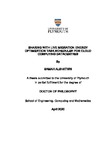SHARING WITH LIVE MIGRATION ENERGY OPTIMIZATION TASK SCHEDULER FOR CLOUD COMPUTING DATACENTRES
| dc.contributor.supervisor | Ghita, Bogdan | |
| dc.contributor.author | Alshathri, Samah | |
| dc.contributor.other | School of Engineering, Computing and Mathematics | en_US |
| dc.date.accessioned | 2020-04-15T12:25:07Z | |
| dc.date.available | 2020-04-15T12:25:07Z | |
| dc.date.issued | 2020 | |
| dc.date.issued | 2020 | |
| dc.identifier | 10502891 | en_US |
| dc.identifier.uri | http://hdl.handle.net/10026.1/15564 | |
| dc.description.abstract |
The use of cloud computing is expanding, and it is becoming the driver for innovation in all companies to serve their customers around the world. A big attention was drawn to the huge energy that was consumed within those datacentres recently neglecting the energy consumption in the rest of the cloud components. Therefore, the energy consumption should be reduced to minimize performance losses, achieve the target battery lifetime, satisfy performance requirements, minimize power consumption, minimize the CO2 emissions, maximize the profit, and maximize resource utilization. Reducing power consumption in the cloud computing datacentres can be achieved by many ways such as managing or utilizing the resources, controlling redundancy, relocating datacentres, improvement of applications or dynamic voltage and frequency scaling. One of the most efficient ways to reduce power is to use a scheduling technique that will find the best task execution order based on the users demands and with the minimum execution time and cloud resources. It is quite a challenge in cloud environment to design an effective and an efficient task scheduling technique which is done based on the user requirements. The scheduling process is not an easy task because within the datacentre there is dissimilar hardware with different capacities and, to improve the resource utilization, an efficient scheduling algorithm must be applied on the incoming tasks to achieve efficient computing resource allocating and power optimization. The scheduler must maintain the balance between the Quality of Service and fairness among the jobs so that the efficiency may be increased. The aim of this project is to propose a novel method for optimizing energy usage in cloud computing environments that satisfy the Quality of Service (QoS) and the regulations of the Service Level Agreement (SLA). Applying a power- and resource-optimised scheduling algorithm will assist to control and improve the process of mapping between the datacentre servers and the incoming tasks and achieve the optimal deployment of the data centre resources to achieve good computing efficiency, network load minimization and reducing the energy consumption in the datacentre. This thesis explores cloud computing energy aware datacentre structures with diverse scheduling heuristics and propose a novel job scheduling technique with sharing and live migration based on file locality (SLM) aiming to maximize efficiency and save power consumed in the datacentre due to bandwidth usage utilization, minimizing the processing time and the system total make span. The propose SLM energy efficient scheduling strategy have four basic algorithms: 1) Job Classifier, 2) SLM job scheduler, 3) Dual fold VM virtualization and 4) VM threshold margins and consolidation. The SLM job classifier worked on categorising the incoming set of user requests to the datacentre in to two different queues based on these requests type and the source file needed to process them. The processing time of each job fluctuate based on the job type and the number of instructions for each job. The second algorithm, which is the SLM scheduler algorithm, dispatch jobs from both queues according to job arrival time and control the allocation process to the most appropriate and available VM based on job similarity according to a predefined synchronized job characteristic table (SJC). The SLM scheduler uses a replicated host’s infrastructure to save the wasted idle hosts energy by maximizing the basic host’s utilization as long as the system can deal with workflow while setting replicated hosts on off mode. The third SLM algorithm, the dual fold VM algorithm, divide the active VMs in to a top and low level slots to allocate similar jobs concurrently which maximize the host utilization at high workload and reduce the total make span. The VM threshold margins and consolidation algorithm set an upper and lower threshold margin as a trigger for VMs consolidation and load balancing process among running VMs, and deploy a continuous provisioning of overload and underutilize VMs detection scheme to maintain and control the system workload balance. The consolidation and load balancing is achieved by performing a series of dynamic live migrations which provides auto-scaling for the servers with in the datacentres. This thesis begins with cloud computing overview then preview the conceptual cloud resources management strategies with classification of scheduling heuristics. Following this, a Competitive analysis of energy efficient scheduling algorithms and related work is presented. The novel SLM algorithm is proposed and evaluated using the CloudSim toolkit under number of scenarios, then the result compared to Particle Swarm Optimization algorithm (PSO) and Ant Colony Algorithm (ACO) shows a significant improvement in the energy usage readings levels and total make span time which is the total time needed to finish processing all the tasks. | en_US |
| dc.language.iso | en | |
| dc.publisher | University of Plymouth | |
| dc.subject | Cloud Computing | en_US |
| dc.subject.classification | PhD | en_US |
| dc.title | SHARING WITH LIVE MIGRATION ENERGY OPTIMIZATION TASK SCHEDULER FOR CLOUD COMPUTING DATACENTRES | en_US |
| dc.type | Thesis | |
| plymouth.version | publishable | en_US |
| dc.identifier.doi | http://dx.doi.org/10.24382/880 | |
| dc.rights.embargoperiod | No embargo | en_US |
| dc.type.qualification | Doctorate | en_US |
| rioxxterms.version | NA |
Files in this item
This item appears in the following Collection(s)
-
01 Research Theses Main Collection
Research Theses Main


